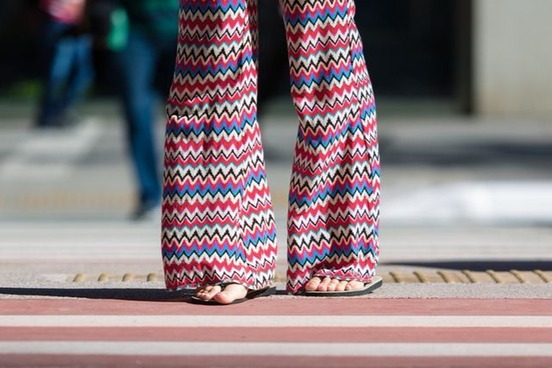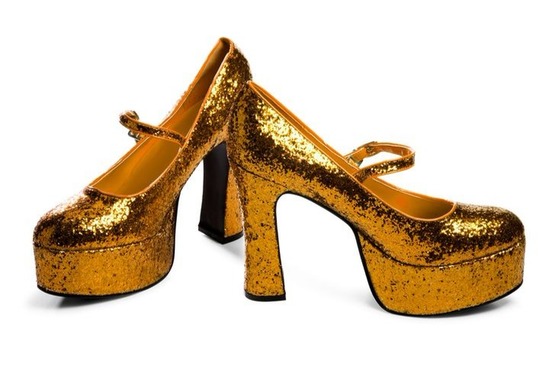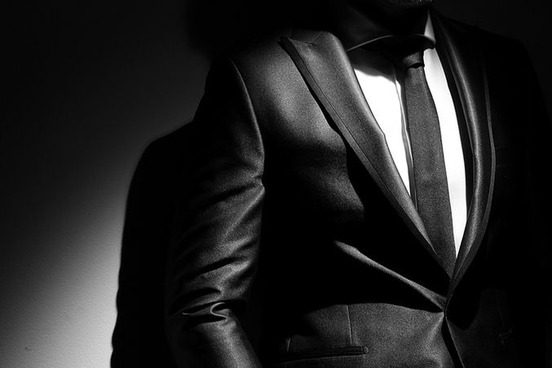
Mod
Mod is a shortening of modern—and perhaps modernist, a term used to describe a player or aficionado of modern jazz. In 1960s Britain, mod identified a young person who dressed stylishly in tailored suits or miniskirts and rode around on a motor scooter listening to the blues and to soul music—rather than the heavier rock music emerging at the time. By association, the name came to be used as an adjective for fashionable people and for things stylish and trendy (in other words, modern).
Modish is also an adjective meaning "fashionable" and "stylish," but it is a much older one (entering English in the mid-1600s) and unrelated, being based on the French word mode, which denotes a way of living, thinking, or dressing.

Rakish
You might be familiar with rake as a word for a dissolute person who leads an immoral life. That rake is a shortening of rakehell, which is presumably derived from the phrase "to rake hell." The expression implies that a person is so bad that one would have to rake the grounds of hell to find his or her equal.
Then, my masters, if you will awhile abide it, / Ye shall see two such knaves so lively described / That, if hell should be raked even by and by indeed, / Such another couple cannot be found, I swear by my creed.
— Ulpian Fulwell, Like Will To Like, 1568
The adjective rakish itself has been used to describe rakehells since the late 1600s. In the early 19th century, another rakish surfaces in English to describe the trim, streamlined appearance of pirate ships. It is based on nautical use of rake for the backward inclination of a ship's mast or the inward slope of its bow or stern. The unconventionality of a ship having a rakish build influenced the use of rakish to describe other things deviating from formality and convention—but, nevertheless, eye-catching—like a hat at a rakish angle.

Fad
Fad applies to anything considered fashionable that is eagerly sought after or pursued, but only for a short period of time. The three-letter word is of unknown origin, which means many armchair etymologists have speculated about its etymology as an acronym. A common notion is that it is an abbreviation of "For A Day." It's compelling, but, according to early print evidence, the word appears in the 19th century to refer to something peculiar that is regularly done out of custom—not because of some transient craze.
"It is very hard: it is your favorite fad to draw plans." "Fad to draw plans! Do you think I only care about my fellow-creatures' houses in that childish way?"
— George Eliot, Middlemarch, 1871
Others have suggested that fad is a shortening of faddle in fiddle-faddle (a reduplication of fiddle, as in fiddlesticks), or even faddle itself, which was once used as a dialectal noun meaning "nonsense" or "foolishness." Another proposed source is fid-fad (a shortening of fiddle-faddle) that is also used in the 19th century in reference to frivolous or trifling people and things.
A more traditional approach to etymology suggests that fad is derived from French fadaise, a word meaning "trifle" or "nonsense." We've fiddled with that, as well as the other ideas on how fad came to be, but have yet to find any concrete evidence supporting the theories.

Trendy
In Middle English, the verb trend had a much different meaning than it does now. Back then, a person trending might be rolling onto his bed or revolving an idea in his head.
He went and trent his bed opon….
— The romance of Guy of Warwick, circa 1330Whoso that seketh sooth by a deep thought … lat hym rollen and trenden withynne hymself the lyht of his ynward sighte.
— Geoffrey Chaucer, Boethius' De Consol. Philosophy, 1374
The "turning" sense of the word then came to refer to the direction that a coastline, river, etc., turned, as in "a coastline that trends westward." By the 19th century, the verb was extended to denote any turning in some direction—for example, "the conversion trended in the direction of politics" or "prices trending upward."
Today, the verb most commonly refers to attention to some hot topic or subject matter. As wordies, we're no strangers to following words that trend. This sense is also behind the participle adjective trending, as in "trending hashtags."
It's also in the 19th century that trend appears as a noun to indicate prevailing tendencies or inclinations ("trends in education") and then current styles or preferences ("new fashion trends"). By mid-20th century, the adjective trendy starts being used to describe people and things being in accordance with the most recent fashions and current ideas.

Funky
"A foul smell" is the original meaning of the noun funk, which has lingered in English since the 17th century. This noun and the verb funk, meaning "to subject to an offensive smell or smoke," probably derive from funquer, a French dialect verb meaning "to give off smoke."
By the end of the 17th century, the adjective funky had been formed from the noun to describe something or someone having an offensive odor, such as "a funky bar" or "a funky armpit." In the early 20th century, the adjective was picked up by jazz musicians who applied it to low-down, earthy, bluesy music. The "Godfather of Soul" James Brown plays on the term's etymological roots in his tongue-in-cheek 1979 single "It's too funky in here": "Too funky in he'e / Gimme some air / Too-woo funky in he'e / Gimme some air / Open up the window, man."
Further amelioration of funky occurred in the 1960s when it came to be used as a generalized term of approval for something unconventionally fashionable.
There were things that shouldn't work together but did, bringing to mind that only-in-New York funky style (silver pants and a matching silver bag, for example, and cowboy shoe boots). There was edgy sportswear and there were paint splatter and squiggle details that seemed to be a love letter to the downtown galleries and streets in the city they are leaving.
— Booth Moore, Hollywood Reporter, 14 Feb. 2017

Dapper
By all appearances, dapper—an adjective used to describe usually men stylishly dressed or old gents having a lively step—is a 15th-century borrowing of the Middle Dutch dapper, meaning "quick" or "strong." It is also akin to Germanic words meaning "heavy" or "stout." Considering the meanings of its etymons, it's puzzling as to how the word came to mean "neat and trim in appearance." Etymologists tend to think that it developed from ironic, joking uses of the word.

Vogue
Vogue is a Middle French borrowing that 16th-century English speakers adopted in a now-archaic sense meaning "the leading place in popularity or acceptance."
The Lord Treasurer Weston is he who hath the greatest vogue now at court, but many great ones have clashed with him.
— James Howell, letter, 1 Jan. 1629
The French word also had nautical meanings referring to the action of rowing, which derive from the verb vogeur, meaning "to sail." The source of that verb is Old Italian vogare, "to row."
Nowadays, vogue generally refers to anything popular or in fashion at a particular time, such as the voguing dance craze in the late 1980s made popular by pop star Madonna. To "vogue" means to strike poses while dancing; the dance is influenced by the poses of models in fashion magazines, like its namesake.

Spiffy
Spiffy, meaning "smart, spruce," occurs about mid-19th century, and is likely tailored from the dialectal adjective spiff.
The origin of spiff is not certain, but there is evidence of it being used in various grammatical forms dating to the 19th century. In dialectal English, it was used as an adjective to describe people and things looking smart and spruce; soon after, it gained slangy use as a noun for a well-dressed man. Additionally, an 1859 slang dictionary records that spiff was used in the clothing industry as a noun with the meaning "the percentage allowed by drapers to their young men when they effect sale of old fashioned or undesirable stock." Later in the century, the verb form occurs to denote the act of sprucing things up. Evidently, the word was fashionable in the 19th century.

Dressed to the nines
The phrase "dressed to the nines," meaning "dressed in a highly elaborate or showy manner," is a specific application of the Scottish phrase "to the nine(s)." Early written evidence of that phrase appeared in the 18th century, and it wasn't originally associated with one's dress.
The bonny Lines therein thou sent me, / How to the nines they did content me.
— William Hamilton, letter, 24 July 1719
Its meaning is "to perfection; just right."
It's speculated that the phrase is derived from the game of ninepins, but the connection is murky: nine is the maximum score possible on any one throw in ninepins, but it is not a perfect score for the game. Nor does the number 9 pin have any special significance in the game. All in all, there is not a definitive explanation of the use of nine in "to the nine(s)."
"Dressed to the nines" pops up in the 19th century, and since that time it has become the most frequent construction in which the old Scottish phrase still occurs.

Dashing
The verb dash is believed to be from Middle French dachier, meaning "to impel forward." It first appears in 13th-century English as a verb for literally—and, later, figuratively—striking something so as to break it into pieces, as in the now common phrases "dashed to pieces" and "dashed hopes."
By the 19th century, the present participle dashing was being used as an adjective to describe someone or something that struck a person as being remarkably spirited or attractive in appearance or manner, as in "a dashing young horse" or "the debutante looked dashing."
A century earlier the noun dash gained a similar meaning, "a flashy or showy display." That sense is commonly found in the expression "to cut a dash."
A quick flick through his feed shows Shaun in fabulous locations, from New York to Paris, cutting a dash in pinstripe suits, casual linens or turtlenecks while sipping coffee or sitting behind the wheel of European sports cars.
— Hannah Davies, The Brisbane (Australia) News, 28 Mar. 2018





